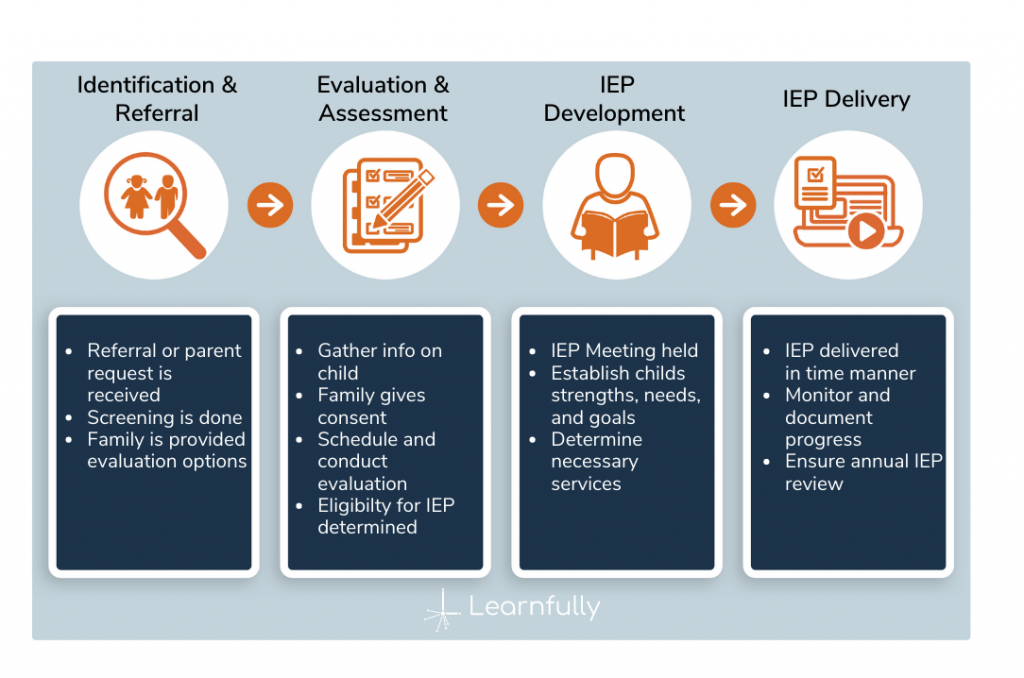This three-part series focuses on the experiences of parents and caregivers of neurodivergent learners as they navigate the many challenges and surprises along the way.
You can find part one here: A Caregiver’s Guide to Neurodivergent Learners: When to Consider an Evaluation.
Or jump to part three here: A Caregiver’s Guide to Neurodivergent Learners: Finding & Measuring Success for Your Child.
What treatment options exist for neurodivergent learners?
While there is no cure for a learning disability, therapeutic treatment and the earliest possible intervention can significantly lessen any negative effects. Children with these differences can develop ways to cope with them using strategies that can be generalized across academic, social, and personal environments.
The most common form treatment takes for a learning disability is that of special education. This will be covered in more detail in the following section, but the basic approach is to teach skills explicitly and sequentially using multisensory instruction that builds on the child’s interests and strengths while correcting any weaknesses. Professionals such as speech and language therapists, and specialists outside the school also may be involved. Some medications may be effective in helping the child learn by assisting with attention and concentration issues. Additional educational, psychological, behavioral, and occupational therapies may also be used.
Dyslexia, the most common learning disability, is a specific learning disability with language. There are no medications for dyslexia or other common types of specific learning disabilities (like dysgraphia, dyscalculia, and dysphoria, among others). Learners with dyslexia need specific and explicit instruction in reading. There are many programs designed to help kids with dyslexia, such as Lindamood-Bell© and Wilson Reading System©. These programs are built on an evidence-based direct instructional approach called Orton-Gillingham (OG). Instruction can be delivered in school as part of an intervention program, or outside of school through a reading specialist. Learnfully’s network of education specialists include many who are certified in OG-based programming.
Treatment for autism spectrum disorder (ASD) consists of a layered approach of medical and therapeutic interventions. Your child’s pediatrician may prescribe speech, behavioral, and occupational therapy. Parents and caregivers of children with ASD must often make a difficult decision whether or not to use medication. There is often no single easy or simple answer; to find the best option for a child with autism, it is recommended that parents work closely with healthcare providers, therapists, teachers, coaches, other family members, and others involved with the child’s treatment [1].
For children with ADHD younger than 6 years of age, the American Academy of Pediatrics (AAP) recommends parent training in behavior management before medication is included with treatment. For children over 6 years, the recommendations include a combination of medication and behavior therapy (with parent training in behavior management if children are under 12) and additional behavior therapy and training for adolescents [2].
Neurodiverse learners with ADHD or ASD often benefit from social-emotional learning skills and executive function training, using programs like Zones of Regulation© or SMARTS EF©, which develop appropriate emotional regulation and executive functioning capabilities (like working memory, planning, and organization skills). Learnfully helps identify these needs in learners and provides them with instruction and therapy using certified education specialists.
Therapeutic models differ in their approach and targeted outcomes. Speech therapy is the assessment and treatment of communication problems and speech disorders. It is performed by speech-language pathologists or speech therapists (SLPs). Speech therapy uses techniques, like articulation therapy or oral motor therapy, to improve communication skills. The specific type of therapy used depends on the speech or language disorder it seeks to correct.
Occupational therapy works to enhance a person’s ability in performing everyday tasks, improving day-to-day life. Occupational therapy is often applied in ASD contexts to help children better process and respond to sensory information. The occupational therapist (OT) will work directly with a child’s parent and treatment team to set goals and progress windows for therapy.
Behavior therapy refers to a broad range of techniques used to address maladaptive behaviors. The goals of behavior therapy are to learn or strengthen positive behaviors and eliminate unwanted or problem behaviors. There are many types of behavioral therapies, and you may have heard of certain behavioral therapies, such as exposure therapy, used in clinical practice.
Learnfully’s network of education specialists includes speech, occupational, and behavior therapists, and education specialists who provide training in behavioral therapies and programming, like Zones of Regulation© and SMARTS EF©, which develop appropriate emotional regulation and executive functioning capabilities.
How an IEP can help (or hinder) your child’s learning
Following your child’s evaluation and diagnosis, the Individualized Education Program (IEP) can be formally developed. The IEP is a written document and educational program which must include all aspects of a child’s individual learning needs. In order for a child to receive special education services they must have an IEP. The IEP has two general purposes: it sets reasonable learning goals for a child, and specifies the services that the school will provide for the child [3].

After the evaluation, the next step required by law is the IEP meeting. As specified by the Individuals with Disabilities in Education Act (IDEA), there are strict legal requirements about who participates. The IEP meeting should include: parents or caregivers, your child’s teacher, a special education teacher, an official representative from the school district, and professionals familiar with your child’s needs and who can interpret the results of their evaluation (including social workers, school psychologists, therapists, or doctors). The law requires the entire team be present for IEP meetings. Your child may also participate and offer input at the meeting when it is appropriate.
| The Individuals with Disabilities Education Act (IDEA) is a law that makes available a free appropriate public education to eligible children with disabilities throughout the nation and ensures special education and related services to those children. Infants and toddlers, birth through age 2, with disabilities and their families receive early intervention services under IDEA Part C. Children and youth ages 3 through 21 receive special education and related services under IDEA Part B. [4] |
Once developed, your child’s IEP plan will include information about their current performance in school, changes to their education programming and services, annual achievement goals, and a set of measurable objectives for each goal. The objectives will be used as indicators to determine whether your child has moved toward or reached a particular goal. Progress for the academic year will be gauged based on achievement of these goals [5].
No IEP is required for a parent or caregiver to engage Learnfully specialists or to get started with educational therapy from our network of education specialists. If you think your child may have a learning difference, contact us for a free consultation.
Out of all of the information contained in your child’s IEP, the most important is the section that outlines the services and support they will receive to help them make academic progress. This section must include a statement of the “special education and related services and supplementary aids and services” that will be provided to your learner. These services must be evidence-based programs founded on peer-reviewed research—this means your IEP team must select and use programs and methodologies that are supported by evidence which proves their effectiveness.
IDEA further defines “special education” as specially designed instruction (“SDI”), specifying that it should meet the unique needs of the child with a disability. SDI essentially means that instructional content, methodology, and delivery (i.e. instruction) must be adapted to meet the needs of your child. The SDI must be integrated with general education curriculum and standards so that your child can meet the same educational standards that apply to their peers.
While many parents have no other recourse, the IEP process can be frustrating and cost them valuable time during a child’s formative learning years. Receiving an IEP is often not a straightforward process, and what the law says versus what a school can realistically provide often means that an effective IEP can take months-to-years to get in place. Parents often notice a difference in their child first—long before this difference shows up as poor grades or social-behavioral issues. The school may not be prepared to pursue an IEP in these early stages, resulting in delays that waste precious intervention time. Reach out to Learnfully for a free consultation—we can get your learner started on a progress plan right away!
|
|
|---|---|
Each child’s IEP must contain specific information, as listed within IDEA, our nation’s special education law. This includes (but is not limited to):
|
What are 504s and IFSPs?
If your child has a medical condition, such as a physical handicap, that doesn’t directly impact academics, but which might require a change to their learning environment, a 504 plan may be used along with or in place of an IEP. Usually, everything that’s in a 504 plan (plus additional services that are only available in the IEP) can be included in an IEP. So if your child already qualifies for an IEP there typically isn’t a reason to also have a 504 plan [6].
If your child is under 3, the IDEA also includes support for the family under the Individualized Family Service Plan (IFSP), which focuses on your child and family, and the services that you need to support the development of your child. IFSPs are created for eligible children who need extra help with physical, language, cognitive, or social-emotional skills. It includes at-home services for speech and language therapy, occupational therapy, vision and audiology services, and other services [7].
Creating a strengths and interests-based learning plan
Science has proven that providing personalized, strengths-based instruction improves a learner’s achievement and outcomes.[8]. Across a variety of domains involving learning differences, studies typically favor instructional approaches that are direct, explicit, and systematic [9]. Learnfully services align with the special education and related services section of a learner’s IEP, utilizing learners’ strengths and interests to remediate educational instruction using multisensory, evidence-based programs. However, no IEP is required for parents or caregivers to engage Learnfully specialists or get started with educational therapy. For this and other reasons, Learnfully can be an attractive alternative to an IEP for caregivers who get stuck navigating the IEP process, or who simply want to get a jumpstart on their child’s progress.
Learnfully employs methodologies and use instructional content from programs like Orton-Gillingham®, Wilson Reading Systems® and Lindamood-Bell®. We also help learners practice academic and social-emotional strategies such as ZONES of Regulation® and SMARTS EF® that help them self-regulate emotions and behavior, and develop executive function skills, like planning and prioritizing. Learn more about Learnfully Services.
In the next part of this blog series: How do you measure progress toward learning goals for kids with learning differences?
[1] Autism Speaks Inc. (n.d.). Treatments for autism. Autism Speaks. Retrieved September 24, 2021, from https://www.autismspeaks.org/treatments-autism.
[2] U.S. Department of Health & Human Services. (n.d.). Treatment of ADHD. Centers for Disease Control and Prevention. Retrieved September 24, 2021, from https://www.cdc.gov/ncbddd/adhd/treatment.html.
[3] U.S. Department of Education, Office of Special Education Programs. (2017, August). The Short-and-Sweet IEP Overview. Center for Parent Information and Resources. Retrieved September 22, 2021, from https://www.parentcenterhub.org/iep-overview/.
[4] U.S. Department of Education. (2020, November 24). About idea. Individuals with Disabilities Education Act. Retrieved September 22, 2021, from https://sites.ed.gov/idea/about-idea/#IDEA-Purpose.
[5] US Department of Education. (2000, July). Guide to the individualized education program. US Department of Education. Retrieved September 22, 2021, from https://www2.ed.gov/parents/needs/speced/iepguide/index.html.
[6] Jones, L. (2020, October 22). Can a student have both an IEP and a 504 Plan? Understood. Retrieved September 22, 2021, from https://www.understood.org/articles/en/can-a-student-have-both-an-iep-and-a-504-plan.
[7] Morin, A. (2021, May 25). What is an IFSP? Understood. Retrieved September 24, 2021, from https://www.understood.org/articles/en/ifsp-what-it-is-and-how-it-works.
[8] National Center for Learning Disabilities. (2017, February 1). The State of LD. National Center for Learning Disabilities. Retrieved September 21, 2021, from https://www.ncld.org/research/state-of-learning-disabilities/.
[9] Spear-Swerling, L. (2005, November). Achieving good outcomes in students with learning disabilities. LD OnLine. Retrieved September 23, 2021, from http://www.ldonline.org/spearswerling/Achieving_Good_Outcomes_in_Students_with_Learning_Disabilities.










